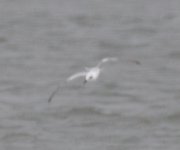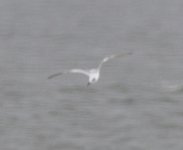-
Welcome to BirdForum, the internet's largest birding community with thousands of members from all over the world. The forums are dedicated to wild birds, birding, binoculars and equipment and all that goes with it.
Please register for an account to take part in the discussions in the forum, post your pictures in the gallery and more.
You are using an out of date browser. It may not display this or other websites correctly.
You should upgrade or use an alternative browser.
You should upgrade or use an alternative browser.
Tern? North Carolina (1 Viewer)
- Thread starter PeteQuad
- Start date
More options
Who Replied?birdmeister
Well-known member

I agree.
Andy Adcock
Worst person on Birdforum

Likely yes, but I do not feel certainty is possible here.
Niels
Correct
A
AlinoVegano
Well-known member
Likely yes, but I do not feel certainty is possible here.
Niels
Which other tern can have a white head with a black spot around the eye?
AlinoVegano
Well-known member
Potentially Gull-billed Tern
That what I thought, but I think we can exclude it with thin bill and wrong upperwing pattern.
AlinoVegano
Well-known member
To me, bill also looks too thin for Forster's (likely something to do with quality of the photo) and in June they should have at least some red to orange in the bill.
Niels
The wing pattern show a immature bird, so black bill is regular. Bill is too thin for Gull-billed, not for Forster's. So I'm trying to say it is 100% Forster's, no other possibilities.
Nutcracker
Stop Brexit!
A vagrant Snowy-crowned Tern . . . ? 3So I'm trying to say it is 100% Forster's, no other possibilities.

I have just checked against a number of my own images all showing Forster's tern with a black bill (earlier in the year so not directly comparable otherwise). These all looked to have considerably larger bills then the OP images show. I will therefore stick to my notion and not sign off on these images being id-able with certainty.
Niels
Niels
AlinoVegano
Well-known member
A vagrant Snowy-crowned Tern . . . ? 3
Actually, we are never sure at 100%, best is 99.xxx % for all identifications o
AlinoVegano
Well-known member
I have just checked against a number of my own images all showing Forster's tern with a black bill (earlier in the year so not directly comparable otherwise). These all looked to have considerably larger bills then the OP images show. I will therefore stick to my notion and not sign off on these images being id-able with certainty.
Niels
Blurred photos give typically an impression of thinner bill. What can it be else, that's my question? If beak is too thin for Forster's in your opinion, for sure you exclude Gull-billed too... then, what else?
Andy Adcock
Worst person on Birdforum

I have just checked against a number of my own images all showing Forster's tern with a black bill (earlier in the year so not directly comparable otherwise). These all looked to have considerably larger bills then the OP images show. I will therefore stick to my notion and not sign off on these images being id-able with certainty.
Niels
The common sense approach
A
AlinoVegano
Well-known member
The common sense approach
A
The first step when identifying a bird is to know a list of possible species. We all agree it is a tern. Now, we all see a black spot around the eye, what are the possible species in North Carolina that match this pattern?
AFAIK, Forster's and Gull-billed, unless I forgot one? Obviously the bill is not one of Gull-billed (although I know bill can look wrong on a blurred photo), and wing pattern is neither matching. We remain with one possibility, Forster's Tern.
Proper comment can be either to agree, or refuse my conclusion... but in case you refuse, you have tell what else could it be!
So I ask again, if you are not sure it is Forster's, what else can it be?
Andy Adcock
Worst person on Birdforum

but in case you refuse, you have tell what else could it be!
That's just the point, we don't 'have' to say what it might be, you already did that. It probably is a Forsters's but you cannot be certain, you make an ID based on probability, is that safe or scientific, what does it achieve?
It goes back to the argument that there are some people who just 'have' to put a name to everything.
A
AlinoVegano
Well-known member
That's just the point, we don't 'have' to say what it might be, you already did that. It probably is a Forsters's but you cannot be certain, you make an ID based on probability, is that safe or scientific, what does it achieve?
It goes back to the argument that there are some people who just 'have' to put a name to everything.
A
Field identification is ALWAYS based on probability. To accept a record, we have to determine if the probability is big enough or not. Close to 100%, but NEVER 100%. If no one can offer another option than Forster's Tern away from a new species for North Carolina or USA, then probability is enough.
You are in Russia, you have Common/Steppe Buzzards I guess. Every time you see a distant buzzard, you put it down as Common/Steppe if you can exclude Rough-legged. And you are right. Although you had not excluded Cape Verde, Mountain, Forest, even Red-tailed, North Africa Long-legged, Japanese Buzzard on plumage, because it is impossible. You put Common/Steppe because it is by very, very, very far the most likely.
All identifications are based on probability.
Users who are viewing this thread
Total: 2 (members: 0, guests: 2)





